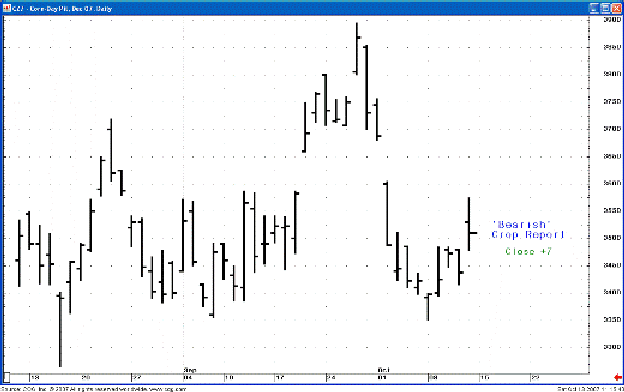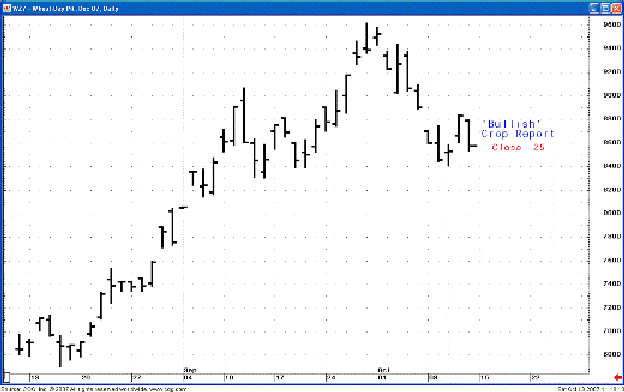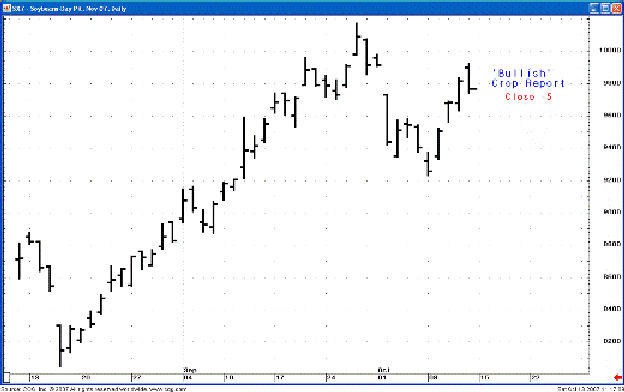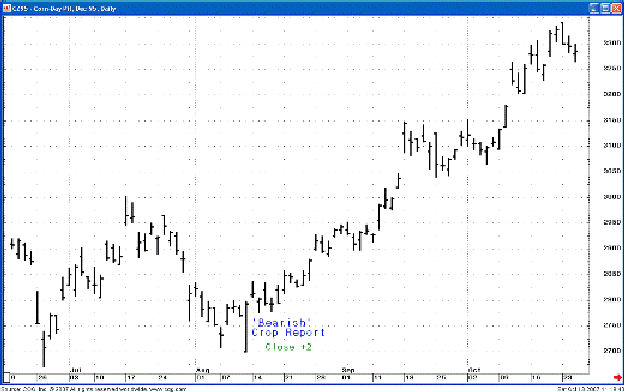Agricultural Commodities Scenerios and Outcomes
Commodities / Agricultural Commodities Oct 17, 2007 - 12:15 AM GMTBy: George_Kleinman

 On any given trading day, for any market, there are four possible scenarios:
1. The market can open higher and close higher. (Bullish)
On any given trading day, for any market, there are four possible scenarios:
1. The market can open higher and close higher. (Bullish)
2. The market can open higher and close lower. (Bearish)
3. The market can open lower and close lower. (Bearish)
4. The market can open lower and close higher. (Bullish)
There are no easy answers to trading; however, in general terms, Nos. 1 and 4 constitute bullish price action, with Nos. 2 and 3 representing bearish price action (at least for that day).
Furthermore, when a trader considers the market's reaction to significant news, there are six possible scenarios:
5. The news is bullish; the market opens higher and closes higher. (Bullish)
6. The news is bullish; the market opens higher and closes lower. (Bearish)
7. The news is bullish; the market opens lower and closes lower. (Bearish)
8. The news is bearish; the market opens lower and closes higher. (Bullish)
9. The news is bearish; the market opens lower and closes lower. (Bearish)
10. The news is bearish; the market opens higher and closes higher. (Bullish)
We consider Nos. 5, 8 and 10 to be bullish price action; in these cases, the market's either responding to bullish news (which is bullish) or not responding to bearish news (also bullish). Nos. 6, 7 and 9 constitute bearish price action. In these cases, the market's either responding negatively to bearish news (bearish) or not responding positively to bullish news (also bearish).
To summarize:
- The bullish camp includes Nos. 1, 4, 5, 8 and 10 above.
- The bearish camp includes Nos. 2, 3, 6, 7 and 9 above.
Now let's put this all to work.
There was a major crop report released Oct. 12. The news was bullish for corn; the record large crop size wasn't increased by the US Dept of Agriculture (USDA) as most analysts expected it would be--a bullish surprise. The corn market opened higher and closed higher. (See No. 1 and No. 5 above.) Both actions are considered bullish.
December 2007 Corn

Source: Commodity.com
The news for wheat, the tightest projected carryover supply since 1949, was bullish. The wheat market opened lower and closed lower. (See No. 3 and No. 7, both bearish.)
December 2007 Wheat

Source: Commodity.com
The soybean news was bullish. (It had lowered acres and no yield increases.) The soybean market opened higher and closed lower. (See No. 2 and No. 6, both bearish.)
November 2007 Soybeans

Source: Commodity.com
To summarize:
- Corn:
News—Bearish
Market Action—Bullish - Wheat:
News—Bullish
Market Action—Bearish - Soybeans:
News—Bullish
Market Action—Bearish
So how can we use this information to potentially profit in the marketplace? I should point out that most analysts are currently bearish for corn because of a record large crop now being harvested, resulting in record large projected supplies. Because of low acres and the associated smaller crop, most analysts are bullish for soybeans.
The consensus for wheat remains bullish because of tight supplies and huge demand despite high prices. The market action after the crop report for these three crops was totally contrary to the common wisdom. It's certainly possible these actions in the marketplace may be random events and only temporary.
In this case, the market should turn “rational” at some point and begin to again move in the direction the fundamentals suggest. However, market action is more important than the news and should be respected.
The corn market action is of particular interest. The crop size is record large, with ending inventories near 2 billion bushels, also a record large bearish number. The USDA estimated corn demand for ethanol to be down 100 million bushels from its previous estimate and cattle numbers (still the largest corn demand source) projected to be down 6 percent into early next year.
There are reports of corn being piled on the ground in some areas of the Midwest because storage facilities are plugged up. So why was the Oct. 12 market action bullish? To be honest, I don't know. But I do know this price action needs to be respected, and in the long run, the market's always right.
Let me share with you a story from corn history: Back in August 1995, the corn market was in a bear trend. A major crop report was released on Aug. 11, 1995; this report was considered bearish. That day, the market opened lower on the report news at $2.70 per bushel, but it closed higher.
Corn didn't trade below $2.70 for the remainder of the year, closing the year out at $3.43. We now know there was bad weather, which reduced the crop size that year, but it didn't take place until after the report day. How did the market know what was going to happen? To be honest, I don't know. But the market was right that year.
December 1995 Corn

Source: Commodity.com
What was even more remarkable was the corn market continued to trend higher for the first six months of 1996, reaching an all-time record high price in the futures of $5.54 on July 12, 1996. What we now know is that, in 1996, China turned from the second-largest corn exporter in the world into a corn importer, and this injected increased demand into a declining supply situation.
The analysts didn't see this coming during the winter of 1995. They were generally bearish, but the market somehow knew. This was the story of the biggest rally in corn market history; that high price has never been exceeded to this date. And it all started with a bearish crop report the market failed to react bearishly to.
I'm not recommending establishing a position in any market based on one day's price action. What I'm saying is, over time, if the market action is contrary to the news, we must respect the market.
Bottom line: If corn prices continue to firm up during the next few weeks, you may reasonably conclude something very bullish is going on in the corn market--perhaps a major price bottom with the associated profit potential.
Good luck, and good trading.
By George Kleinman
President
Commodity Resource Corp.
Lake Tahoe,
Nevada 89452-8700
http://www.commodity.com
George Kleinman is the President of the successful futures advisory and trading firm Commodity Resource Corp. (CRC). George founded CRC in 1983 while on the "floor" of the Minneapolis Grain Exchange to offer a more personalized level of service to traders. George has been an Exchange member for over 25 years. George entered the business with Merrill Lynch Commodities (1978 - 1983). At Merrill he attained the honor of 'Golden Circle' one of Merrill's top ten commodity brokers internationally. He is a graduate of The Ohio State University with an MBA from Hofstra University. George has developed his own proprietary trading techniques and is the author of three books on commodity futures trading published by the Financial Times.
He is Executive Editor of Futures Market Forecaster, a KCI Financial publication. In 1995, George relocated CRC to Nevada and today trades from an office overlooking beautiful Lake Tahoe. The firm assists individuals and corporate clients. CRC¹s exclusive clearing firm is R.J. O'Brien with all client funds held at RJO (assets in excess of $1.9 billion). Founded in 1914, R.J. O'Brien is a privately owned Futures Commission Merchant, and one of the most respected independent futures brokerage firms in the industry. RJO is a founding member of the Chicago Mercantile Exchange, a full clearing member of the Chicago Board of Trade, New York Mercantile Exchange, Commodity Exchange of New York and the New York Board of Trade. RJO offers the latest in order entry technology coupled with 24-hour execution and clearing on every major futures exchange worldwide. There is risk of loss when trading commodity futures and this asset class is not appropriate for all investors.
Risk Disclaimer
Futures and futures options can entail a high degree of risk and are not appropriate for all investors. Commodities Trends is strictly the opinion of its writer. Use it as a valuable tool, not the "Holy Grail." Any actions taken by readers are for their own account and risk. Information is obtained from sources believed reliable, but is in no way guaranteed. The author may have positions in the markets mentioned including at times positions contrary to the advice quoted herein. Opinions, market data and recommendations are subject to change at any time. Past Results Are Not Necessarily Indicative of Future Results.
Hypothetical Performance
Hypothetical performance results have many inherent limitations, some of which are described below. No representation is being made that any account will or is likely to achieve profits or losses similar to those shown. In fact, there are frequently sharp differences between hypothetical performance results and the actual results subsequently achieved by any particular trading program. One of the limitations of hypothetical performance results is that they are generally prepared with the benefit of hindsight. In addition, hypothetical trading does not involve financial risk, and no hypothetical trading record can completely account for the impact of financial risk in actual trading. For example, the ability to withstand losses or to adhere to a particular trading program in spite of trading losses are material points which can also adversely affect actual trading results. There are numerous other factors related to the markets in general or to the implementation of any specific trading program which cannot be fully accounted for in the preparation of hypothetical performance results and all of which can adversely affect actual trading results.
George Kleinman Archive |
© 2005-2022 http://www.MarketOracle.co.uk - The Market Oracle is a FREE Daily Financial Markets Analysis & Forecasting online publication.


